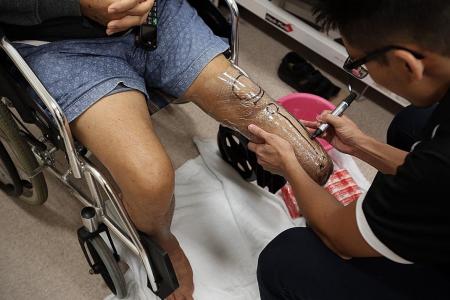Prompt treatment can save limbs from diabetes
S'pore hospitals see about four amputations a day because of diabetes
Every year, Singapore hospitals perform roughly 1,500 diabetes-related amputations.
This works out to about four amputations a day - a number that may go up as Singapore deals with a growing diabetes problem.
The amputations are mainly due to peripheral arterial disease (PAD) - the narrowing or blockage of lower limb arteries.
As a result, muscles and tissues in the lower limbs receive little to no oxygen- and nutrient-rich blood.
It is especially prevalent in diabetic patients who have poor or suboptimal blood glucose control, said Dr Benjamin Chua, a vascular and endovascular surgeon at Mount Elizabeth Hospital.
"This is further aggravated if patients also have poorly controlled blood cholesterol levels or continue to smoke cigarettes.
"Aside from diabetes, other risk factors include chronic smoking, hypertension and end-stage renal failure," he said.
There are some signs that indicate the onset of PAD, including severe cramping pain at the affected part of the legs, such as the thigh, calf or foot.
"This severe cramping pain usually sets in after a repeated, fixed distance of walking or duration of exercise and is relieved by simply standing still," said Dr Chua.
"If left untreated, these patients may gradually find they can no longer walk or exercise for long without pain.
"As a result, many of these patients find themselves limiting their mobility to avoid the pain."
As PAD progresses, patients may start to feel pain in their lower limb even at rest, especially when lying down. They may also find their affected lower limb cold and pale.
"Some of these patients may go on to develop non-healing foot ulcers, or their toes or foot lose body tissues as a result of loss of blood," said Dr Chua.
This may lead to life-threatening sepsis, a condition where infection-fighting chemicals released into the blood cause inflammation instead, he added.
"Other signs of progression of PAD include absent limb pulses and pus discharge from the wounds.
"These patients require urgent treatment as they have a significant risk of undergoing major below-knee or above-knee amputations resulting in limb loss."
But amputations do not have to happen if detected early.
Simple clinical tests to diagnose PAD, such as the ankle-brachial pressure index, can be used to determine the severity of PAD.
The test involves taking the systolic blood pressure in the legs and comparing it with that in the arms.
Once diagnosed, additional ultrasound or CT scans of the lower limb arteries can help determine which parts of the arteries are diseased.
MEDICAL THERAPY
For patients with mild to moderate PAD, medical therapy - monitoring risk factors, exercise therapy and anti-platelet drugs - works well.
Exercise therapy, which involves getting patients to continue walking despite the pain, can encourage small arteries to enlarge so as to supplement new blood supply to the limb muscles, Dr Chua explained.
Antibiotics can also be prescribed for wound infections that are detected early, and infected tissues can be removed while making sure as much as possible to preserve a functional lower limb and foot.
"After removing the infected tissues, a wide range of techniques are available to care for the resultant wound.
"If it is large, skin may be taken from other parts of the body to cover the wounds. This process then allows the patient to regain their mobility and resume their activities of daily living," said Dr Chua.
For those with severe conditions, angioplasty and stenting may be recommended to reopen or widen the blocked arteries, and prevent them from narrowing or being blocked again.
Noting that amputations affect not only the patients but also put emotional and financial strains on people around them, Dr Chua said: "Early intervention for diabetics with PAD is crucial in ensuring patients retain mobility.
"The rapidly improving techniques and technology now offer most patients a lower-risk solution to saving their lower limbs. When combined with advanced wound care techniques, patients whose options for limb salvage were once limited can now look forward to avoiding limb loss."
Get The New Paper on your phone with the free TNP app. Download from the Apple App Store or Google Play Store now


